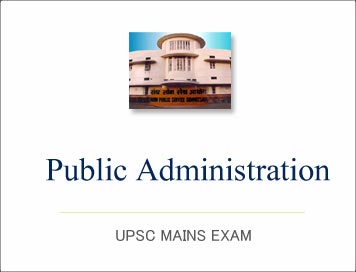(Download) UPSC IAS Mains 2013 : Public Administration
(Download) UPSC IAS Mains 2013 : Public Administration
Paper - I
:: Section A ::
Q.1 Answer the following, questions in not more than 150 words each. 5 questions x 10 marks each.
-
How did the traditional Public Administration resolve the fundamentally irresolvable problem- creating an administration strong enough to be effect but not strong enough to endanger accountability?
-
The theory of organizational incompetence has two separate and distinct faces. Examine Chris Argyris’ views on this
-
In the globalized Public Administration, hierarchy creates more ethical problems than it solves. Comment
-
Public Administration in the neo-liberal era is government less by the instruments of accountability and more by those of external accountability Elaborate
-
Discuss the views that “tribunals should have the same degree of independence from the Executive as that enjoyed by the supreme court and high courts, especially for those tribunals that look over the functions of high courts.
-
New Public Administration may have neither been the savior its enthusiasts promised, nor the devil its critics worried it would be. Discuss.
-
“The design of physical structures, the anatomy of the organization came first, and was indeed the principle consideration.” “An organization is a system of interrelated social behaviors of participants” Analyses these statements and evaluate the contribution of the respective approach to Administrative theory.
-
Decisions are not made by organizations, but by human beings behaving as the members of organizations. How do Bernard and Herbert A. Simon conceptualize the relation between decision of the individual employee and the organizational authority?
-
A variety of different organizational arrangement can be used to provide different public goods and services. Example the theory underlying this proposition and its potential contribution.
-
What is the nature of psychological contract persued by organizational management through authority and employees through exertion of upward influence?
-
Structure theory is by and large, grounded in classical principles of efficiency, effectiveness and productivity.
-
Public interest is still inadequate as a ground concept to evaluate public policy.
:: Section B ::
Q.5Answer all five, in not more than 150 words each. 10 marks x 5 = 50 marks.
-
Comparative Public Administration both resembles and differs from modern organization theory. elaborate
-
In organizational analysis, there is always gender around (Gouldner). Argue
-
What is Administrative elitism? How does it evolve in Public Administration? elaborate your response with reference to historical examples
-
The success of e-government projects in most developing countries s is state to be rather low. Assess the reason.
-
What new models of budgetary capacity and incapacity have emerged after the decline of planning programming budgeting and zero based budgeting?
-
“For those who use the euphemism of ‘shared power’ for participation, the appropriate literature for guidance is practical politics and not organization and Management.” “Stronger state and strong civil society are the need to develop both participatory democracy and responsive government as mutually reinforcing and supportive.” Bring out the myths and realities associate with public participation.
-
“….in most cases….newly independent states, of the nations of Africa, Asia and Latin America, despite their differences…are in transition.” (Ferrel Heady). What common features are indicative of characteristics of their Administrative patterns (cultures)?
-
“To talk about the regulatory framework is to talk about short governance.” Analyze the statement in the context of public private partnership and identify the elements of regulation.
-
Economic reforms are a work in progress, with the state reluctant to fully relinquish its reins. Discussion the statement with regard to implementation of economic reforms in India .
-
“the policy process was not structured in the way required by bureaucratic planning.” ”Arguably, instrumentalism now stands most in contrast to neo liberal nationality that impose market against both gradual change and democratic liberalism.” analyses these two statements. 20 marks.
-
Budget allocations involves series of tensions between actors with different backgrounds, orientations and interests and between the short term goals and long term institutional requirements. Discuss. 15 marks
(a) Read following instances carefully and suggest what specific perspectives on organizational psychology of motivation would help the concerned organization to reconcile the needs of the following four persons with the needs of organization: 30m
-
Mr.A comes to his office with clocklike punctuality; does his work with impeccable honesty and integrity; takes orders from above gladly; responds well to overtures by peers; but neither mixes with anyone himself nor seeks anyone’s company. what is more, he seem quite happy in his isolation.
-
Mr.B is an efficient charge hand at the welding shop. He is very outgoing and makes friends fast, but falls out with them very fast too. He is, however, easily pacified when anyone asks him to calm down in the name of the organization.
-
Mr.C is completely happy and absorbed when he is teaching in the classes, and doesn’t at all mind when is workload gets heavier and covers new areas. But he gets angry when the finance section raises objection about his medical bills; and is furious that the higher administration is yet to give him full tenure.
-
Mr.D is a metallurgist in the forge shop of the steel plan, and has received honors for his innovativeness in modifying conventional alloys. He also paints well and values his painting skills far more than his metallurgy and is extremely unhappy that company house journal did not finally carry his water sketch on its front cover.
(b). Suppose the government of India is thinking of constructing a dam in a mountain valley girded by forests and inhibited by ethnic communities. What rational techniques of policy analysis should it resorts to for coping with likely uncertainties and unforeseen contingencies.


